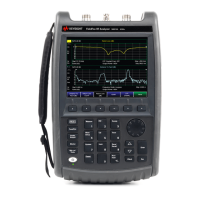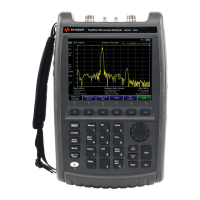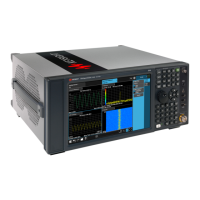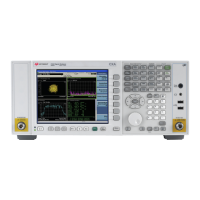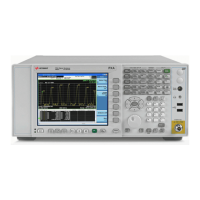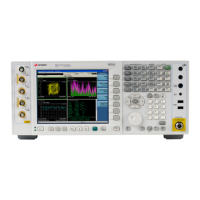250 Keysight N9927-90001 User’s Guide
IQ Analyzer (IQA) – Option 351 (CPU2 Only)
I/Q Analyzer (IQA) Mode Settings
——Then depending on the trigger type selected, choose from the
following:
Trig Level
– Sets the trigger level. This softkey is only active for
Video or RF Burst (default: –25 dBm, minimum: –210 dBm,
maximum: 30 dBm).
Trig Slope
– Sets the negative/positive trigger slope. This
softkey is only active for External, Video, or RF Burst (default:
Pos).
Trig Delay
– Sets the trigger delay. This softkey is only active
for External, Video, or RF Burst (default: 0s, minimum:
–150 ms, maximum: 500 ms).
Glitch Mask
– Enables the glitch mask to reduce incorrect
triggering due to fast changes/glitches in the signal level that
can be mistaken to be the edge of the RF burst. This softkey is
only active for RF Burst (default: 0 ms, minimum: 0s,
maximum: 5 ms).
Auto Trigger
– While waiting for a valid trigger signal, Wait is
annotated in the top left corner of the FieldFox screen.
If a valid trigger signal is not received before the specified Auto
Trig Time, a acquisition will occur automatically.
Enter 0 to set Auto Trigger OFF. When Auto Trigger is OFF, the
FieldFox does NOT perform an acquisition unless a valid
trigger signal is received.
(Default: 100 ms, minimum: 1 ms, maximum: 100s)
Adjusting the Measurement Setup Settings
—Press Meas Setup 4.
— Then choose from the following:
— Average Type
Opens a menu of averaging softkeys.
Then select one of the following:
——Power
(Linear) Averaging – Best for measuring true power
levels. Used in Noise Marker Average. Mathematically, trace
noise is 2.5 dB higher than when using Log Average. PAvg
annotation is displayed.
——Log
Averaging (default) – Best for displaying Trace Averaging.
Also known as video averaging. LgAvg annotation is displayed.
——Voltage
(Magnitude) Averaging – Converts the amplitudes to a
magnitude unit before averaging (e.g., Volts, Amps,
microVolts, milliVolts, etc.) VAvg annotation is displayed.

